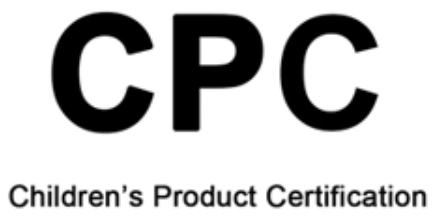Relationship between CPC, CPSC and CPSIA
In one sentence, the Children's Product Safety Certificate (CPC) is tested by a laboratory authorized by the Consumer Product Safety Association (CPSC) in accordance with the Consumer Product Safety Act (CPSIA).
Remarks: CPC=CPSIA+ASTM F963, CPSIA is only a section of children's product safety testing, mainly testing phthalates and total lead. ASTM F963 is an American toy test standard, which mainly tests toy mechanical physics, combustion, total lead, and migration of 8 major heavy metals.
CPSC
CPSC is an important consumer rights protection agency in the United States. It is the abbreviation of Consumer Product Safety Committee, that is, Consumer Product Safety Association. The CPSC certification we often say refers to the need to find a third-party laboratory authorized by CPSC to issue test documents. The U.S. Consumer Product Safety Commission (CPSC) was established in 1972. Its responsibility is to protect the interests of consumers and maintain personal and family safety by reducing the risk of injury and death from consumer products.
The main functions of CPSC are: to formulate self-discipline standards for producers, and to formulate mandatory standards or prohibitions for those consumer products that have no standards to follow. Perform inspections of potentially hazardous products and provide feedback to consumers through various channels including the media, state, local government, individual groups and organizations. CPSC is now responsible for the safety monitoring of more than 15,000 consumer products. Children's Product Certificate is a certificate issued by a third-party laboratory authorized by CPSC after testing products in accordance with regulations and based on test data.
More consultation Baidu search: Shenzhen Tonglian Testing
CPSIA Act
CPSIA is the Security Improvement Act signed into effect by President Bush on August 14, 2008. The Act is the toughest consumer protection act since the establishment of the Consumer Product Safety Commission (CPSC) in 1972.
CPSIA imposes stricter requirements on lead content in children's products and restricts the use of six specific phthalates in toys and child care products. In addition, the regulations impose the following requirements on the safety compliance of children's products:
1. Conduct compliance testing in a CPSC-approved laboratory;
2. Obtain a children's product certificate (issued by the manufacturer or importer) to prove the conformity of the product;
3. CPSC establishes a publicly accessible database of children's product accident injury reports
Implementation purpose:
1. Establish a unified mandatory national standard in the United States.
2. Further standardize lead-containing toys.
3. A traceability label is attached to the toy.
4. Convert the voluntary standard ASTM F963 into a mandatory standard.
5. Implement compulsory third testing for some children's products n control 6 kinds of phthalates in toys.
Scope of control
CPSC certifies regulated products and substances for up to 15,000 consumer products used in the home, sports, recreation and schools. However, products such as vehicles, tires, ships, weapons, alcohol, tobacco, food, drugs, cosmetics, pesticides and medical devices are not within its jurisdiction.
Most consumer products and substances are regulated by the CPSC, especially those primarily intended for children 12 years of age or younger, click here to view the cpc list of regulated products, including but not limited to the following:
1. All Terrain Vehicle (ATV)
2. Bicycles
3. Bunk bed
4. Cosmetics
5. Baby Bodyguard/Jumper/Pacer
6. Battery
7. Apparel Textiles
8. Fire Extinguisher
9. Floor covering adhesive
10. Food
11. Carpet
12. Vinyl Plastic Film
CPC certificate
The full name of Children's Product Certificate (Children's Product Certificate), the US mandatory regulation CPSIA (Children's Product Safety Promotion Act) stipulates: Children's product manufacturers and importers must provide written children's product certificates based on the test results of CPSC-accredited third-party laboratories ( CPC) to certify that its products comply with the appropriate Children's Product Safety Regulations.
The safety of children's products has always attracted much attention, and it has always been the focus of spot checks by market supervision departments. Children's products often appear in foreign recall notices. Children's products sold to the United States will face the risk of being reviewed, unable to be put on the shelves or taken off the shelves if they lack test reports and certificates. Children's products listed on e-commerce platforms must meet the requirements of relevant children's product regulations just like traditional retail store sales channels. It is necessary to upload the compliance test report of children's products and the Children's Product Certificate (CPC) before selling products on the platform.
The CPC certificate must contain the following information:
1- Product information (name and description);
2- All laws and regulations applicable to the product;
2- All laws and regulations applicable to the product;
3- Information of the importer or manufacturer (Continental United States): including name, address and telephone number;
4- Contact information of the holder of the test result file supporting the certificate: name, address, email address and telephone;
5- The production date and address of the product, the production date must be in the year and month, and the address must be in the city;
6- The time and address of the test or the test report on which the certificate is based;
7- Information of third-party testing organization (CPSC-accredited laboratory): name, address, contact number.
CPC testing standard:
A total of 38 standards have been published by CPSC, and the main testing contents are:
1) CPSIA total lead and phthalates;
2) American toy standard ASTMF963;
3) Electric toys safety standard 16 CFR Part 1505;
4) Rattle toys require 16 CFR Part 1510;
5) Pacifier safety standard 16 CFR Part 1511;
6) Children's clothing, carpet combustion performance, such as 16 CFR Part 1610;
7) Children's products: baby carriages, cribs, fences, harnesses, safety seats, bicycle helmets and other product standards.
CPC certificate application process:
1. Sign the contract and provide samples and product information and application form according to the requirements of the laboratory;
2. After the laboratory receives the samples, it will conduct product testing according to the standard requirements;
3. After passing the test, issue a test report;
4. Issue the certificate.
Cycle: 7 working days
